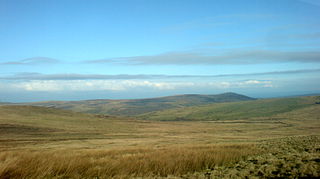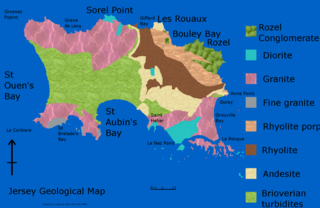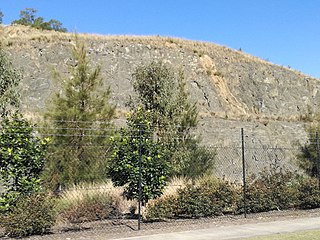Related Research Articles

Slate is a fine-grained, foliated, homogeneous, metamorphic rock derived from an original shale-type sedimentary rock composed of clay or volcanic ash through low-grade, regional metamorphism. It is the finest-grained foliated metamorphic rock. Foliation may not correspond to the original sedimentary layering, but instead is in planes perpendicular to the direction of metamorphic compression.

Gravel is a loose aggregation of rock fragments. Gravel occurs naturally on Earth as a result of sedimentary and erosive geological processes; it is also produced in large quantities commercially as crushed stone.

Blackheath is a town in the Sandwell Metropolitan Borough, in the county of West Midlands, England.

The Preseli Mountains, also known as the Preseli Hills, or just the Preselis, is a range of hills in western Wales, mostly within the Pembrokeshire Coast National Park and entirely within the county of Pembrokeshire.

Bluestone is a cultural or commercial name for a number of dimension or building stone varieties, including:

Diabase, also called dolerite or microgabbro, is a mafic, holocrystalline, subvolcanic rock equivalent to volcanic basalt or plutonic gabbro. Diabase dikes and sills are typically shallow intrusive bodies and often exhibit fine-grained to aphanitic chilled margins which may contain tachylite.

Tividale is a district of the Metropolitan Borough of Sandwell, West Midlands.

Tyndall Stone is a registered trademark name by Gillis Quarries Ltd. Tyndall Stone is a dolomitic limestone that is quarried from the Selkirk Member of the Ordovician Red River Formation in the vicinity of Garson and Tyndall, Manitoba, Canada. It is a cream-coloured limestone with a pervasive mottling of darker dolomite. The mottling gives the rock a tapestry-like effect, and it is popular for use as a building and ornamental stone.

Titterstone Clee Hill, sometimes referred to as Titterstone Clee or Clee Hill, is a prominent hill in the rural English county of Shropshire, rising at the summit to 533 metres (1,749 ft) above sea level.

Pemulwuy is a suburb in Greater Western Sydney, in the state of New South Wales, Australia. Pemulwuy is located 30 kilometres west of the Sydney central business district in the local government area of the Cumberland Council. Pemulwuy is home to the highest point between the Blue Mountains and Sydney, the summit of Prospect Hill.
Industrial resources (minerals) are geological materials that are mined for their commercial value, which are not fuel and are not sources of metals but are used in the industries based on their physical and/or chemical properties. They are used in their natural state or after beneficiation either as raw materials or as additives in a wide range of applications.

Breidden Hill is a steep-sided hill in Powys, Wales, near the town of Welshpool. It is immediately surrounded by the villages of Trewern, Middletown, Criggion, Crew Green and Llandrinio. The peak of the hill reaches to 367 metres (1,204 ft). Footpaths which lead up to the summit provide excellent 360 degree views over Powys and over the border with England to the Shropshire Plain.

Crushed stone or angular rock is a form of construction aggregate, typically produced by mining a suitable rock deposit and breaking the removed rock down to the desired size using crushers. It is distinct from naturally occurring gravel, which is produced by natural processes of weathering and erosion and typically has a more rounded shape.

The geology of Jersey is characterised by the Late Proterozoic Brioverian volcanics, the Cadomian Orogeny, and only small signs of later deposits from the Cambrian and Quaternary periods. The kind of rocks go from conglomerate to shale, volcanic, intrusive and plutonic igneous rocks of many compositions, and metamorphic rocks as well, thus including most major types.

Kentish ragstone is a hard grey limestone in Kent, England, drawn from the geological sequence known as the Hythe Beds of the Lower Greensand. For millennia it has been quarried for use both locally and further afield.
The Sulphur Mountain Formation is a geologic formation of Early to Middle Triassic age. It is present on the western edge of the Western Canada Sedimentary Basin in the foothills and Rocky Mountains of western Alberta and northeastern British Columbia. It includes marine fossils from the time shortly after the Permian-Triassic extinction event.

Wenvoe Quarry is an operational quarry located on the eastern edge of the Vale of Glamorgan, south Wales, approximately 5 km southwest of Cardiff city centre. It is situated on Alps Quarry Road, in an area known as "The Alps", between Wenvoe, Culverhouse Cross and Caerau. The quarry is accessed from the A4050 road.

Barrow Hill Local Nature Reserve is a local nature reserve situated in Pensnett in the county of West Midlands, England. Its most distinctive feature, Barrow Hill, is the eroded remnant of a high level igneous intrusion that was formed 315 million years ago during the Carboniferous period. The reserve was created in 2005.

The Derbyshire Dome is a geological formation across mid-Derbyshire in England.

The Prospect dolerite intrusion, or Prospect intrusion, is a Jurassic picrite or dolerite laccolith that is situated in Sydney, New South Wales, Australia. Lying in the heart of Cumberland Plain, in the suburb of Pemulwuy, the intrusion is Sydney's largest body of igneous rock, rising to a height of 117 metres (384 ft) above sea level. The site is formed by an intrusion of dolerite rock into Ashfield Shale. At least seven different rock types occur in the intrusion.
References
- 1 2 Bristow, C.M.; Sedman, J.; Beatty, D.; Nice S.; Lucas H.; Griffiths R.; Stanton W.; Harrison D.; Barrett B.; Roberts D. (2002). "Appendix 1: The field excursions at the conference". In Scott P.W. & Bristow C.M. (ed.). Industrial minerals and extractive industry geology: based on papers presented at the combined 36th Forum on the Geology of Industrial Minerals and 11th Extractive Industry Geology Conference, Bath, England, 7th-12th May, 2000. Special publication. London: Geological Society. p. 368. ISBN 978-1-86239-099-7 . Retrieved 2 January 2011.
- ↑ "End of an era as quarry closes". Express & Star. MNA media. Retrieved 2 January 2012.